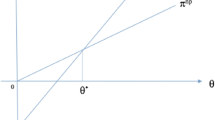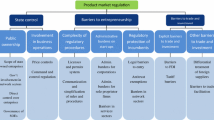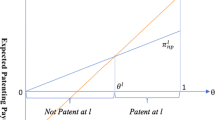Abstract
This paper sheds light on firm-level heterogeneity in patent propensity by studying the relationship between ownership structure and patenting activity in Italian manufacturing firms from 2006 to 2013. Both patent and accounting data are extracted from the Bureau van Dijk’s Orbis database. Our empirical findings show that ownership concentration increases the probability of successful patent applications, but at decreasing returns to scale. Moreover, there is a close association between several firm-level dimensions and innovative performance. Some differences arise when large firms and SMEs are examined separately, but the analysis as a whole would confirm the importance of ownership concentration for patenting activity. The empirical results hold also when the analysis explicitly deals with the endogeneity problem.

Similar content being viewed by others
References
Acs, Z. J., & Audretsch, D. B. (1987). Innovation, market structure and firm size. Review of Economics and Statistics, 69(4), 567–574. https://doi.org/10.2307/1935950.
Aghion, P., Van Reenen, J., & Zingales, L. (2009). Innovation and institutional ownership. NBER Working Paper Series, No. 14769.
Amore, M., Schneider, C., & Zaldokas, A. (2013). Credit supply and corporate innovation. Journal of Financial Economics, 109(3), 835–855.
Anderson, R. C., & Reeb, D. M. (2003). Founding family ownership and firm performance: Evidence from the S&P 500. Journal of Finance, 58(3), 1301–1328. https://doi.org/10.1111/1540-6261.00567.
Andres, C. (2011). Family ownership, financing constraints and investment decisions. Applied Financial Economics, 21(22), 1641–1659. https://doi.org/10.1080/09603107.2011.589805.
Archibugi, D. (2001). Pavitt’s taxonomy sixteen years on: A review article. Economics of Innovation and New Technology, 10(5), 415–425.
Arora, A., Ceccagnoli, M., & Cohen, W. (2008). R&D and the patent premium. International Journal of Industrial Organization, 26(5), 1153–1179.
Arundel, A., & Kabla, I. (1998). What percentage of innovations are patented? Empirical estimates for European firms. Research Policy, 27(2), 127–141.
Astrachan, J. H., Klein, S. B., & Smyrnios, K. X. (2002). The F-PEC scale of family influence: A proposal for solving the family business definition problem. Family Business Review, 15(1), 31–58.
Barontini, R., & Caprio, L. (2005). The effect of family control on firm value and performance: Evidence from continental Europe. European Financial Management, 12(5), 689–723.
Baum, C. F. (2012). Sspecialreg: Stata module to estimate binary choice model with discrete endogenous regressor via special regressor method. http://ideas.repec.org/c/boc/bocode/s457546.html. Accessed 1 Oct 2014.
Baysinger, B. D., Kosnik, R. D., & Turk, T. A. (1991). Effects of board and ownership structure on corporate R&D strategy. The Academy of Management Journal, 34(1), 205–214.
Belcher, A., Hassard, J., & Procter, S. (2002). R&D decisions: Strategy, policy and innovations. Abingdon: Routledge.
Belloc, F., Laurenza, E., & Rossi, M. A. (2016). Corporate governance effects on innovation when both agency costs and asset specificity matter. Industrial and Corporate Change, 25(6), 977–999.
Benfratello, L., Schiantarelli, F., & Sembenelli, A. (2008). Banks and innovation: Microeconometric evidence on Italian firms. Journal of Financial Economics, 90(2), 197–217.
Beyer, M., Czarnitzki, D., & Kraft, K. (2012). Managerial ownership, entrenchment and innovation. Economics of Innovation and New Technology, 21(7), 679–699.
Boldrin, M., & Levine, D. (2012). The case against patents. Federal Reserve Bank of St. Louis, Working Paper Series, Working Paper no. 035. http://research.stlouisfed.org/wp/2012/2012-035.pdf.
Bound, J., Cummins, C., Griliches, Z., Hall, B. H., & Jaffe A. B. (1984). Who does R&D and who patents? In Z. Griliches (Ed.), R&D, patents, and productivity. Chicago, IL: Chicago University Press.
Campello, M., Graham, J., & Harvey, C. (2010). The real effects of financial constraints: Evidence from a financial crisis. Journal of Financial Economics, 97(3), 470–487.
Carlsson, B., Jacobsson, S., Holmen, M., & Rickne, A. (2002). Innovation systems: Analytical and methodological issues. Research Policy, 31(2), 233–245.
Cebula, R. J., & Rossi, F. (2015). Ownership structure and R&D: An empirical analysis of Italian listed companies. PSL Quarterly Review, 68(275), 297–325.
Chava, S., Oettl, A., Subramanian, A., & Subramanian, K. (2013). Banking deregulation and innovation. Journal of Financial Economics, 109(3), 759–774.
Chen, V., Li, J., Shapiro, D. M., & Zhang, X. (2014). Ownership structure and innovation: An emerging market perspective. Asia Pacific Journal of Management, 31(1), 1–24.
Chesbrough, H. W. (2003). Open innovation: The new imperative for creating and profiting from technology. Boston: Harvard Business Press.
Choi, S. B., Park, B. I., & Hong, P. (2012). Does ownership structure matter for firm technological innovation performance? The case of a Korean firm. Corporate Governance: An International Review, 20(3), 267–288.
Cohen, W. (1995). Empirical studies in innovative activity. In P. Stoneman (Ed.), Handbook of the economics of innovation and technological change. Oxford: Blackwell.
Cohen, W., & Klepper, S. (1996a). A reprise of size and R&D. The Economic Journal, 106, 925–951. https://doi.org/10.2307/2235365.
Cohen, W., & Klepper, S. (1996b). Firm size and the nature of innovation within industries: The case of process and product R&D. The Review of Economics and Statistics, 78(2), 232–243.
Cohen, W., Nelson, R., & Walsh, J. (2000). Protecting their intellectual assets: Appropriability conditions and why U.S. manufacturing firms patent (or not). NBER Working Paper 7552.
Corrado, C. A., Hulten, C. R., & Sichel, D. E. (2006). Intangible capital and economic growth. NBER Working Paper 11948. http://www.nber.org/papers/w11948.pdf.
Corrado, C. A., Hulten, C. R., & Sichel, D. E. (2009). Intangible capital and U.S. economic growth. Review of Income and Wealth, 55(3), 661–685. https://doi.org/10.1111/j.1475-4991.2009.00343.x.
Crépon, B., Duguet, E., & Mairesse, J. (1998). Research, innovation, and productivity: An econometric analysis at the firm level. Economics of Innovation and New Technology, 7(2), 115–158.
De Rassenfosse, G. (2010). How much do we know about firms’ propensity to patent and should we worry about it? In Summer conference 2010 - Opening up innovation: Strategy, organization and technology, Imperial College London Business School, June 16–18, 2010.
Dong, Y., & Lewbel, A. (2012). A simple estimator for binary choice models with endogenous regressors. Resource document. Boston College. http://fmwww.bc.edu/EC-P/wp807.pdf. Accessed 30 Oct 2013.
Duchin, R., Ozbas, O., & Sensoy, B. (2010). Costly external finance, corporate investment, and the subprime mortgage credit crisis. Journal of Financial Economics, 97(3), 418–435.
Edquist, C. (1997). System of innovation: Technologies, institutions and organisations. London: Pinter.
Feldman, M. P., & Audretsch, D. B. (1999). Innovation in cities: Science-based diversity, specialisation and localised competition. European Economic Review, 43(2), 409–429.
Francis, J., & Smith, A. (1995). Agency costs and innovation: Some empirical evidence. Journal of Accounting and Economics, 19(2–3), 383–409.
Freeman, C., & Soete, L. (1997). The economics of industrial innovation. London: Pinter.
Fujita, M., & Thisse, J. F. (2002). Economics of agglomeration—Cities, industrial location and regional growth. Cambridge: Cambridge University Press.
Glaeser, E. (1999). Learning in cities. Journal of Urban Economics, 46(2), 254–277.
Griliches, Z. (1990). Patent statistics as economic indicators: A survey. Journal of Economic Literature, 28(4), 1661–1707.
Hasan, T., Quayes, S., & Khalily, B. (2018). Role of governance on performance of microfinance institutions in Bangladesh. Eurasian Economic Review. https://doi.org/10.1007/s40822-018-0102-8.
Hosono, K., Tomiyama, M., & Miyagawa, T. (2004). Corporate governance and research and development: Evidence from Japan. Economics of Innovation and New Technologies, 13(2), 141–164.
Jensen, M., & Meckling, W. (1976). Theory of the firm: Managerial behavior, agency costs, and capital structure. Journal of Financial Economics, 3(4), 305–360.
Johansson, B., & Loof, H. (2008). Innovation activities explained by firm attributes and location. Economics of Innovation and New Technology, 17(6), 533–552.
Johansson, B., & Quigley, J. M. (2004). Agglomeration and networks in spatial economies. Papers in Regional Science, 83(1), 165–176.
Kleinknecht, A., & Mohnen, P. (Eds.). (2002). Innovation and firm performance: Econometric explorations of survey data. Basingstoke: Palgrave.
Kleinknecht, A., Van Montfort, K., & Brouwer, E. (2002). The non-trivial choice between innovation indicators. Economics of Innovation and New Technology, 11(2), 109–121.
La Porta, R., Lopez-de-Silanes, F., & Shleifer, A. (1999). Corporate ownership around the world. Journal of Finance, 54(2), 471–517.
La Porta, R., Lopez-de-Silanes, F., Shleifer, A., & Vishny, R. W. (1998). Law and finance. Journal of Political Economy, 106(6), 1113–1155.
La Porta, R., Lopez-de-Silanes, F., Shleifer, A., & Vishny, R. W. (2000). Investor protection and corporate governance. Journal of Financial Economics, 58(1–2), 3–27.
Lanjouw, J., & Schankerman, M. (2004). Patent quality and research productivity: Measuring innovation with multiple indicators. Economic Journal, 114(495), 441–465.
Leary, M. (2009). Bank loan supply, lender choice, and corporate capital structure. Journal of Finance, 64(3), 1143–1185.
Lee, P. M., & O’Neill, H. M. (2003). Ownership structures and R&D investments of U.S. and Japanese firms: Agency and stewardship perspectives. Academy of Management Journal, 46(2), 212–225.
Lemmon, M., & Roberts, M. (2010). The response of corporate financing and investment to changes in the supply of credit. Journal of Financial and Quantitative Analysis, 45(3), 555–587.
Lerner, J. (1995). Patenting in the shadow of competitors. Journal of Law and Economics, 38(2), 463–495.
Levin, R. C., Klevorick, A. K., Nelson, R. H., & Winter, S. (1987). Appropriating the returns from industrial research and development. Brookings Papers on Economic Activity, 3, 783–831.
Lewbel, A. (2000). Semiparametric qualitative response model estimation with unknown heteroscedasticity or instrumental variables. Journal of Econometrics, 97(1), 145–177.
Lewbel, A. (2004). Simple estimators for hard problems: Endogeneity in discrete choice related models. Resource document. Boston College. https://www2.bc.edu/~lewbel/simple6.pdf. Accessed 26 Oct 2013.
Lewbel, A. (2014). An overview of the special regressor method. In J. S. Racine., L. Su & A. Ullah (Eds.), Oxford handbook of applied nonparametric and semiparametric econometrics and statistics.
Lewbel, A., Dong, Y., & Yang, T. T. (2012). Comparing features of convenient estimators for binary choice models with endogenous regressors. Canadian Journal of Economics, 45(3), 809–829.
Lewbel, A., & Schennach, S. (2007). A simple ordered data estimator for inverse density weighted functions. Journal of Econometrics, 136(1), 189–211.
Lotti, F., & Marin, G. (2013). Matching of PATSTAT applications to AIDA firms: Discussion of the methodology and results (June 20, 2013). Bank of Italy Occasional Paper 166. Available at SSRN: http://ssrn.com/abstract=2283111 or http://dx.doi.org/10.2139/ssrn.2283111.
Lundvall, B. A. (1992). National system of innovation: Towards a theory of innovation and interactive learning. London: Pinter.
Mansfield, E. (1986). Patents and innovation: An empirical study. Management Science, 32(2), 173–181.
Mejer, M. (2012). Economic incongruities in the European patent system. European Journal of Law and Economics, 34(1), 215–234.
Minetti, R., Murro, P., & Paiella, M. (2015). Ownership structure, governance, and innovation. European Economic Review, 80(3), 165–193.
Motohashi, K. (2011). Innovation and entrepreneurship: A first look at linkage data of Japanese patent and enterprise census. Resource document. Research Institute of Economy, Trade and Industry (RIETI). http://www.rieti.go.jp/jp/publications/dp/11e007.pdf. Accessed 10 Dec 2013.
Nelson, R. R. (1993). National innovation systems: A comparative analysis. New York: Oxford University Press.
Nelson, R. (2003). On the uneven evolution of human know-how. Research Policy, 32(6), 909–922.
Pederzoli, C., Thoma, G., & Torricelli, C. (2013). Modelling credit risk for innovative SMEs: The role of innovation measures. Journal of Financial Services Research, 44(1), 111–129.
Petersen, M. A., & Rajan, R. G. (1992). The benefits of firm-creditor relationships: evidence from small business data. University of Chicago Working Paper n. 362.
Scherer, F. M. (1990). Industrial market structure and economic performance. Chicago, IL: Rand McNally.
Shapiro, D., Tang, Y., Wang, M., & Zhang, W. (2015). The effects of corporate governance and ownership on the innovation performance of Chinese SMEs. Journal of Chinese Economic and Business Studies, 13(4), 311–335.
Slaughter, S., & Leslie, L. (1997). Academic capitalism: politics, policies and the entrepreneurial university. Baltimore, MD: Johns Hopkins University Press.
Squicciarini, M., Dernis, H., & Criscuolo, C. (2013). Measuring patent quality: Indicators of technological and economic value. OECD Science, Technology and Industry Working Papers, 2013/03, OECD Publishing, Paris. http://dx.doi.org/10.1787/5k4522wkw1r8-en.
Sutton, J. (1998). Technology and market structure. Cambridge, MA: MIT Press.
The Economist (2012). The big engine that couldn’t. May 19th 2012.
The Economist (2015). Innovation. Time to fix patents. August 8th 2015.
Villalonga, B., & Amit, R. (2006). How do family ownership, control, and management affect firm value? Journal of Financial Economics, 80(2), 385–417.
World Bank (2015a). Worldwide Governance Indicators (WGI). www.govindicators.org.
World Bank (2015b). Doing Business Report 2015. Going bejond efficiency.
Yafeh, Y., & Yosha, O. (2003). Large shareholders and banks: Who monitors and how? The Economic Journal, 113(484), 128–146.
Author information
Authors and Affiliations
Corresponding author
Appendix
Appendix
1.1 Special regression method for binary choice model
To handle the problem of endogeneity, the empirical econometric literature suggests the use of instrumental variables. However, the latter are often unavailable or too weak and in same cases it is a hard task to find good instruments that fit well with models. To circumvent this difficulty, we adopt an alternative approach proposed by Lewbel: the special regressor method (Lewbel 2014; Lewbel et al. 2012; Dong and Lewbel 2012). This methodology, which is based on earlier seminal work by the same author (Lewbel 2000), is relatively easy to implement and relies on assumptions that are quite different from those required for maximum likelihood estimators. The special regressor approach does not impose restrictions on the model errors and does not require the relationship between the endogenous and exogenous regressors to be specified, but its consistency relies on the presence of one exogenous regressor that is conditionally independent of the model error, is continuously distributed, and has a large support. The special regressor thus provides a simple way of testing the validity of the modeling assumptions underlying more standard maximum likelihood approaches.
The special regressor approach proposed by Lewbel (2000) was designed in a broad context to improve the identification and estimation of parameters and their associated distributions in general threshold-crossing models such as the following binary decision model:
where D represents the binary decision variable, the vector X includes all observable regressors, ε has a zero mean distribution, and I(·) is the indicator function taking the value one if the latent variable X′β + ε is positive and zero otherwise. Traditional probit and logit models correspond to the case of ε following a normal and exponential distribution, respectively.
The special regressor model has the same form as model (1) but is rewritten so that one regressor V (that is called the special regressor) is separated from the other regressors X and its coefficient is normalized to one:
The special regressor V must satisfy three fundamental conditions:
-
V is continuously distributed and has a large support (i.e., V varies on a support that is as large as the support of X′β + ε);
-
V is exogenous;
-
E(D|X, V) increases with V.
If some elements of X are endogenous, then the special regressor method requires instruments satisfying the following usual properties: E(Z′ε) = 0 and E(Z′X) has full rank. The special regressor V should not be included in the set of instruments Z which implies that a suitable V should only affect the binary decision of interest, and not the endogenous (binary) variable. Further, note that only one special regressor is needed whatever the number of endogenous variables in the model.
The basic idea behind the special regressor approach is briefly described below (while we refer to Lewbel (2014) for additional details).
Define T as:
where fV|Z(V|Z) denotes the conditional probability density function of V given Z. Under the above assumption, it can be shown that E(T|Z) = E(X′β + ε|Z), assuming ε is independent of V|Z (Lewbel 2014). It follows from the latter equality that E(ZX′)β = E (Z T) and so:
which is the definition of a linear two-stage least squares regression of T on X using instruments Z. We describe below the steps to be followed to estimate and the parameters of interest β (see Dong and Lewbel 2012 for more insight about technical details):
-
Step 0: V must be of mean zero; if not, one must first de-mean it.
-
Step 1: Run an Ordinary Least Squares (OLS) regression of V on (X, Z) and, for each observation i, compute the residuals as the difference between the observed Vi and its prediction: \({\hat{U}}_{i} = V_{i} - (X^{\prime}_{{\hat{b}_{X}}} + Z^{\prime}_{{\hat{b}_{Z}}} )\), where \(\hat{b}_{X} {\text{ and }}\hat{b}_{Z}\) are the OLS estimated coefficients for variables in X and Z, respectively.
-
Step 2: Compute \(\hat{f}_{h}\) as the non-parametric kernel estimator of the density f of \(\hat{U}\) and for each I compute the estimates \(\hat{f}_{i} = \hat{f}(\hat{U}_{i} )\). Note that such estimation requires a kernel K(·) and a bandwidth to be chosen. Alternatively, one may use the ordered data estimator proposed by Lewbel and Schennach (2007). See also Dong and Lewbel (2012) for details.
-
Step 3: For each observation i construct:
$$\hat{T}_{i} = \frac{{D_{i} - I(V_{i} \ge 0)}}{{\hat{f}_{i} }}.$$Note that in this ratio the denominator can take very small values especially for large absolute values of \(\hat{U}_{i}\). As a consequence, some could have extremely large absolute values, which could induce large standard errors in the final two-stage least squares regression. Lewbel (2014) recommends either removing these extreme values for example using a trimming procedure.
-
Step 4: Compute \(\hat{\beta }\) as the coefficient of a two-stage least squares regression of \(\hat{T}\) on X using instruments Z.
The estimation of the special regressor thus involves four steps that can be implemented relatively easily in most statistical software: a procedure is available in STATA (see Baum 2012). Further, classical tests of the validity of the instruments can be applied at the final two-stage least squares regression knowing that E(Zε) = E(Z \(\tilde{\varvec{\varepsilon }}\)) with \(\tilde{\varvec{\varepsilon }}\) = T − X′β, the error term of the Step 4 regression (see Dong and Lewbel 2012).
Rights and permissions
About this article
Cite this article
Succurro, M., Costanzo, G.D. Ownership structure and firm patenting activity in Italy. Eurasian Econ Rev 9, 239–266 (2019). https://doi.org/10.1007/s40822-018-0109-1
Received:
Revised:
Accepted:
Published:
Issue Date:
DOI: https://doi.org/10.1007/s40822-018-0109-1




